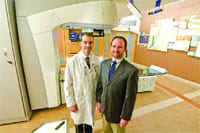Concussion: the Invisible Injury
For years, athletes and coaches downplayed the injury, calling it merely a ‘ding,’ or getting your ‘bell rung.’ No longer. Concussion has finally captured the attention it deserves.
The potential of severe long-term health effects from concussion has raised alarms at all levels of sport, from professional to youth leagues. It has also elevated fears among parents about their children’s participation in sports.
This greater awareness is welcome because, with thousands of young people engaged in sports and recreational activities, concussion has become a widespread public-health issue. The U.S. Centers for Disease Control estimates that up to 4 million concussions occur in sports each year.
Simply stated, concussion is an injury to the brain. The human brain is a soft organ, composed of about 75{06cf2b9696b159f874511d23dbc893eb1ac83014175ed30550cfff22781411e5} water with the consistency of gelatin, that sits inside the skull. A hard jolt to the head causes the brain to move suddenly, stretch and elongate, and hit the skull, causing a concussion. That jolt can leave microscopic structural changes to the brain.
Diagnosing a concussion, however, can be difficult. It is an ‘invisible’ injury, with no instantly recognizable signs of harm such as bleeding, bruising, or pain. It also presents with vague, neurological symptoms: headache, trouble with vision or balance, nausea, and memory or sleep disturbances are common symptoms. And it does not require loss of consciousness.
Adding to the difficulty is the fact that no definitive diagnostic test is now available for concussions. Doctors currently use a series of tests, including balance testing, a visual test, cognitive testing, and a physical exam.
When a player is suspected of having a concussion, the athlete should be taken out of play immediately and not be allowed to return until a medical professional completes an examination. The phrase, ‘if in doubt, pull them out’ should apply above all other considerations. Fortunately, most schools have now established safety protocols to protect players. Teammates, too, can play an important role, watching out for each other to see if someone appears confused or reacts strangely after being hit.
With proper rest, most concussions are resolved in about 10 days with no persistent problems. But reasons for concern still exist. The cognitive consequences of a concussion must be recognized — that young athletes may have difficulty with schoolwork after being hit, and the time for recovery may vary among individuals.
The potential and consequences of a second concussion must also be considered. The shorter the interval is between impacts, the more dangerous the second injury becomes. In a small number of cases, the effects of concussion may persist and go on to develop long-term problems. These long-term issues are usually directly linked to the time of exposure: the longer one plays, the higher the risk.
Another concern is ‘sub-concussive’ hits to the head: minor impacts to the head that present no symptoms. Mounting evidence shows that too many of these minor hits may also cause microscopic changes to the brain.
Parents of young children should be extra cautious and vigilant. The brains of younger children are still developing, so they are more susceptible to concussion and take longer to recover. For sports with lots of contact, it’s best to wait until the body is physically mature. Deciding when that is, however, can be tricky; it’s likely to occur at different ages for different people.
Concussions occur more often in collision sports such as football, but they can occur in any sport and to males and females alike. Women’s soccer, for example, reports the second-highest number of concussions, and some studies suggest that women are more susceptible to the injury than men.
Although the potential for concussion is real in sports, it’s also important to recognize that team sports have great value for youngsters. We know that enormous benefits are gained from exercise — physically, emotionally, and psychologically — so we don’t want young people to stop playing sports. What we do want is for them to play safe and play smart, so that impacts to the head are not putting their long-term health at risk. Developing skills and techniques to avoid direct hits to the head, for example, can help to reduce the incidence of concussion.
For more information on concussion, visit the Concussion Legacy Foundation at www.concussionfoundation.org or the Mass. Department of Public Health at www.mass.gov/sportsconcussion. For a video discussion, visit www.physicianfocus.org/concussions.
Dr. Ann McKeen is chief of Neuropathology at the VA Boston Healthcare System and professor of Neurology and Pathology and director of the Chronic Traumatic Encephalopathy Center at the Boston University School of Medicine. This article is a public service of the Mass. Medical Society.



Comments are closed.